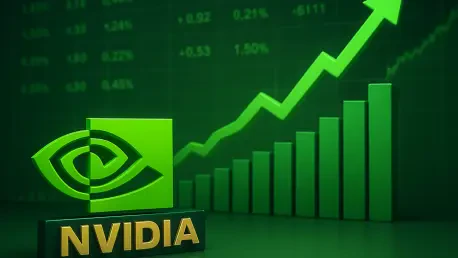In an era where technology stocks can sway entire markets with a single earnings report, the upcoming results from Nvidia stand as a potential turning point for the tech sector, particularly amid heightened global economic uncertainty. With a staggering $320 billion swing in market value hanging in the balance, investors are on edge, wondering if the AI boom will continue to fuel growth or falter under scrutiny of overvaluation. Meanwhile, a pause in the U.S. tech selloff and Japan’s financial struggles with a weakening yen add layers of complexity to the global landscape. This roundup gathers diverse opinions, tips, and strategic insights from industry analysts, economists, and market watchers to help navigate these turbulent waters. The purpose is to distill varied perspectives on Nvidia’s pivotal moment, U.S. market dynamics, and international pressures, offering a comprehensive guide for investors facing an unpredictable horizon.
Setting the Stage for Critical Market Shifts
The financial world is at a crossroads, with Nvidia’s earnings report poised to either validate or challenge the fervor surrounding AI investments. Industry observers note that the tech sector’s recent volatility, marked by a four-day decline in major U.S. indices, has momentarily stabilized as anticipation builds. This pause, however, is fragile, with broader concerns about economic indicators and global instability looming large.
Beyond U.S. borders, Japan’s economic challenges, including a depreciating currency and surging bond yields, are creating ripple effects. Analysts highlight that these issues, combined with geopolitical tensions, underscore a period of uncertainty that could impact investment strategies worldwide. The convergence of these events has sparked intense debate among experts about potential market directions.
This roundup aims to capture the spectrum of thought on how these interconnected forces might shape the near term. From tech valuations to international fiscal policies, the insights gathered here provide a multifaceted view of risks and opportunities, helping stakeholders prepare for various outcomes.
Diverse Perspectives on Key Market Forces
Nvidia’s Earnings: A Defining Test for AI Momentum
Market analysts are sharply divided on what Nvidia’s upcoming earnings might signal for the tech sector, especially regarding AI-driven growth. Some industry commentators argue that a strong report could reinforce confidence, potentially driving further investment into AI technologies and pushing Nvidia’s market cap to new heights. They point to the company’s dominant position in the AI chip market as a foundation for sustained optimism.
Conversely, a segment of financial experts cautions against excessive enthusiasm, suggesting that disappointing results could confirm fears of overvaluation. They emphasize that a $320 billion market value swing reflects not just Nvidia’s performance but also broader anxieties about whether the AI sector’s growth is sustainable. This group advises investors to brace for volatility, as even minor shortfalls could trigger significant selloffs.
Strategic tips from market watchers include closely monitoring Nvidia’s forward guidance rather than just quarterly figures. Many suggest that indications of future AI demand and spending trends will be critical in assessing long-term viability. This balanced approach, they argue, helps in distinguishing between short-term noise and enduring trends in the tech landscape.
U.S. Tech Selloff: Temporary Respite or Deeper Concerns?
The recent pause in the U.S. tech selloff, following declines in the S&P 500 and Nasdaq, has prompted mixed reactions from economic analysts. Some view this stabilization as a breather, driven by anticipation of Nvidia’s earnings, with a potential for renewed buying if results exceed expectations. They note that mixed economic signals, such as rising jobless claims, have yet to fully deter investor sentiment in tech.
Others, however, see this lull as a mere delay before deeper corrections, pointing to disappointing earnings from major firms outside tech as a warning sign. These analysts highlight concerns over Federal Reserve policy, with fears of a hawkish stance delaying rate cuts and pressuring tech valuations further. Their perspective underscores the fragility of current market confidence amid inconsistent data.
Investment strategists recommend a cautious stance, suggesting diversification beyond tech-heavy portfolios to mitigate risks. They advise keeping a close eye on upcoming Federal Reserve communications, particularly the release of meeting minutes, for clues on interest rate trajectories. Such vigilance, according to these experts, is essential in navigating potential policy-driven market shifts.
Japan’s Economic Challenges: Yen and Bond Market Turmoil
Turning to Asia, Japan’s financial struggles have drawn significant attention from global economists, with the yen’s decline to multi-year lows sparking varied interpretations. Some market observers attribute this weakness to political pressures on the Bank of Japan, especially with a proposed 25 trillion yen stimulus budget raising questions about fiscal discipline. They warn of potential global currency market disruptions stemming from these policies.
A differing viewpoint comes from analysts who see Japan’s bond yield surges as a more immediate concern, reflecting market unease over loosening fiscal controls. They argue that rising yields on long-term Japanese government bonds could signal diminishing confidence in central bank independence, potentially affecting international bond markets. This perspective emphasizes the broader implications for global fixed-income strategies.
Practical advice from financial consultants includes monitoring Japan’s policy developments for signs of further yen depreciation, which could impact export-driven economies. They also suggest considering safe-haven assets to hedge against currency volatility in the region. These tips aim to equip investors with tools to manage risks arising from Japan’s economic tightrope.
Global Tensions and Economic Interconnections
Geopolitical and economic ripples beyond the U.S. and Japan are also shaping market sentiment, with analysts offering contrasting takes on their impact. Some experts focus on China’s ban on Japanese seafood imports as a sign of escalating trade tensions, predicting negative effects on Asian market stability. They see such actions as adding to the uncertainty already present in currency and equity markets.
Others highlight more positive developments, such as Britain’s slowing inflation potentially leading to earlier rate cuts, as a counterbalance to global volatility. These commentators suggest that such policy shifts could provide relief to risk assets, offering opportunities for investors to pivot toward regions with easing monetary conditions. This optimistic view contrasts with broader concerns about interconnected risks.
Investment advisors stress the importance of a global outlook, recommending that portfolios account for cross-border economic events. They propose staying updated on international data releases, like inflation figures or trade policy changes, to anticipate sudden market movements. This proactive approach, they argue, is vital in a landscape where regional issues quickly become global challenges.
Strategic Takeaways for Investors
Synthesizing these varied insights, several key points emerge for those navigating current market conditions. Nvidia’s earnings stand as a critical test for the tech sector, with outcomes likely to influence perceptions of AI investment viability. Analysts collectively urge a balanced approach, focusing on both immediate results and long-term indicators to gauge true sector health.
Uncertainty around U.S. monetary policy remains a central theme, with experts advising close attention to Federal Reserve signals to anticipate impacts on tech valuations. Diversifying investments across sectors is frequently cited as a prudent strategy to cushion against potential downturns driven by tighter policy expectations.
Japan’s fiscal and currency challenges, alongside global geopolitical tensions, further complicate the investment environment. Recommendations include adjusting risk exposure based on upcoming economic data and maintaining flexibility to adapt to sudden policy or trade developments. These strategies, drawn from a range of expert views, aim to provide a roadmap through an uncertain financial terrain.
Reflecting on Insights and Next Steps
Looking back on the discussions captured in this roundup, the depth of analysis from various market experts paints a vivid picture of a financial world grappling with interconnected challenges. The polarized views on Nvidia’s earnings underscore the high stakes for the tech sector, while concerns over U.S. policy and Japan’s economic struggles highlight the fragility of global stability. Each perspective contributes to a richer understanding of the risks and opportunities at play during this pivotal moment.
Moving forward, investors are encouraged to leverage these insights by prioritizing adaptability in their strategies. Exploring further resources on central bank policies and geopolitical trends can deepen comprehension of potential market movers. Additionally, engaging with platforms that track real-time economic data offers a practical way to stay ahead of shifts, ensuring informed decision-making in response to evolving global dynamics.









